Maximizing B2B Results through Video Marketing
- Home
- Maximizing B2B Results through Video Marketing
Video marketing has become a crucial aspect of the B2B marketing landscape. With an increasing number of consumers turning to video content for information and entertainment, B2B organizations are leveraging this medium to reach and engage their target audience. From product demos to thought leadership content, video has proven to be an effective tool for building brand awareness, generating leads, and nurturing relationships with prospects and customers. In this discussion, we'll explore the role of video marketing in B2B and its impact on business growth and success.
Video Maturity Model
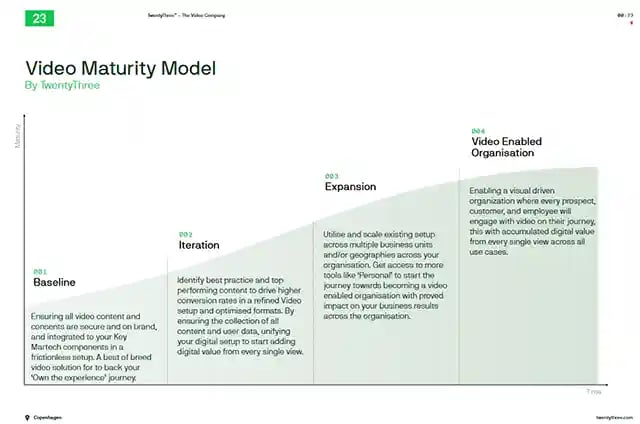
- Baseline
Baseline is the foundation of video marketing, which helps organizations create secure, consistent and on-brand video content that aligns with their business objectives. It's important to have a proper setup in place to ensure that the videos and the consent for using them are secure and within the brand guidelines. A Baseline setup also includes the integration of key marketing technology components to make the video experience frictionless for the audience. Having a best-of-breed video solution in place helps in taking control of the video experience and elevating it to the next level, thereby making the journey of owning the experience a success.
- Iteration
The iteration phase of the Video Maturity Model focuses on using data and insights to continuously improve and enhance the video strategy. This phase involves identifying the best practices and top-performing video content to drive higher conversion rates. This can be achieved by refining the video setup and optimizing the formats used. In this phase, it's important to collect all content and user data, unifying the digital setup to start adding digital value from every view. This allows companies to continuously learn and adapt to their target audience, creating a more personalized and effective video experience for their customers. By consistently gathering data and insights, companies can refine their video strategy to improve performance and drive better results.
- Expansion
Expansion is a phase of the video maturity model where an organization utilizes and expands its existing video setup to multiple business units and/or across different geographies. The focus is on scaling the solution and making it accessible to a wider audience. This involves integrating new tools and features, such as "Personal," which help the organization move closer to becoming a "video-enabled organization." By expanding the video solution, the organization can demonstrate the impact of video on their overall business results, which will help drive continued growth and adoption of the technology. The goal is to effectively leverage the investment made in video so that it can be scaled to provide benefits to the organization as a whole.
- Video Enable Organisation
The fourth stage of the Video Maturity Model is the Video Enable Organisation. This is a stage where an organization fully embraces video as a key component of its marketing, sales and communication strategies. In this stage, the organization has created a seamless and integrated video solution that provides value to every prospect, customer, and employee. This video solution is designed to be frictionless, allowing everyone to engage with video on their journey smoothly and seamlessly.
At this stage, the organization has also accumulated digital value from every single view of the video, which has had a positive impact on their business results across the organization. The use of video has been scaled across multiple business units and geographies, and the organization has access to more tools and resources that help it become a truly video-enabled organization. The goal of the Video Enable Organisation is to create an environment where visual storytelling and communication are at the heart of the organization's culture and operations, driving growth and success.
Current State of Video
The current state of video in B2B marketing is rapidly evolving. Companies are recognizing the potential of video as a powerful tool for engaging customers and building brand awareness. With 85% of people expressing a desire to see more videos from brands, businesses are taking advantage of this trend by creating video content that is informative, engaging, and relevant to their target audience.
Despite the growing popularity of video marketing, measuring its impact and ROI can be a challenge for many companies. While 78% of businesses believe in data-driven marketing, 70% acknowledge that they have poor or inconsistent customer data. This disconnect between business and customer needs can limit the effectiveness of video marketing efforts.
To overcome this challenge, companies need to adopt a practical, goal-driven approach to video creation. This starts with a creative brainstorm, followed by the identification of video topics and ideation, video production, and video optimization. By focusing on their objectives and leveraging data and analytics, companies can create videos that have a measurable impact on their business.
Video for business vs video for customers
Video for business vs video for customers refers to the different types of video content that companies create for different purposes. Video for business is typically created for internal or external use by the company. It might be used for training, marketing, or communicating with employees or stakeholders. This type of video is meant to support the goals and objectives of the business.
 Video for customers, on the other hand, is created specifically for the end-user. It's meant to educate, inform, or entertain the customer and help build a relationship with them. This type of video is meant to engage the customer and build brand loyalty. The goal of a customer-facing video is to create a positive experience for the customer, leading to increased customer engagement, loyalty, and ultimately, sales.
Video for customers, on the other hand, is created specifically for the end-user. It's meant to educate, inform, or entertain the customer and help build a relationship with them. This type of video is meant to engage the customer and build brand loyalty. The goal of a customer-facing video is to create a positive experience for the customer, leading to increased customer engagement, loyalty, and ultimately, sales.
Companies need to understand the difference between these two types of video, as they have different goals, audiences, and methods of measuring success. By understanding this distinction, companies can create video content that is both effective and relevant for their intended audience.
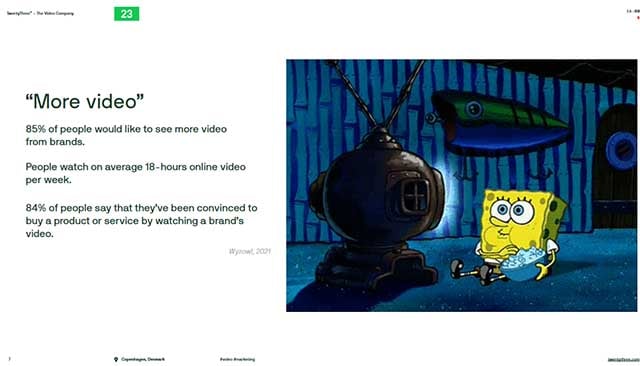
Measuring video impact or ROI

Measuring video impact or ROI is crucial for determining the success of a video marketing campaign. This involves calculating the return on investment for the time and resources invested in creating and distributing the video. It requires setting clear goals for the video and tracking the following metrics:
- Views: The number of people who have watched the video
- Engagement: The level of interaction with the video, such as likes, shares, and comments
- Lead generation: The number of leads generated as a result of the video
- Conversion rate: The percentage of viewers who take a desired action, such as making a purchase or filling out a form
- Sales: The revenue generated as a result of the video
By tracking these metrics, businesses can determine the effectiveness of their video marketing efforts and make data-driven decisions for future campaigns.
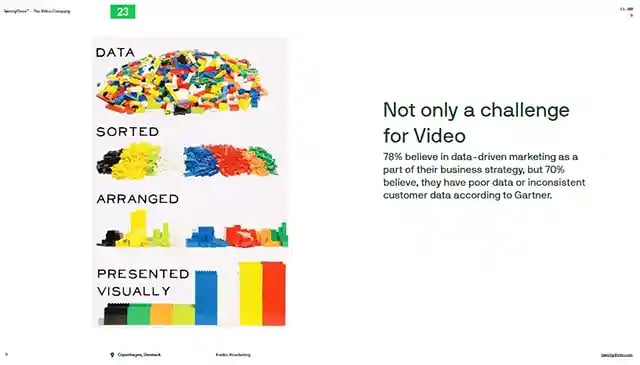
Why do we have this disconnect between businesses and customers?
The disconnect between businesses and customers regarding video content can be attributed to various reasons such as the difference in expectations and preferences, the lack of proper data analysis, and the misalignment of marketing strategies with customer needs. Businesses may see video content as a way to promote their products or services, whereas customers may prefer educational or entertaining content. The lack of data analysis can result in businesses not knowing what type of content resonates with their customers. Also, a marketing strategy that does not align with customer needs may not result in the desired impact and engagement. Therefore, it is crucial for businesses to understand their customers' preferences and expectations and to create a strategy that aligns with these.
Video Creation - Practical Approach: Form Driven
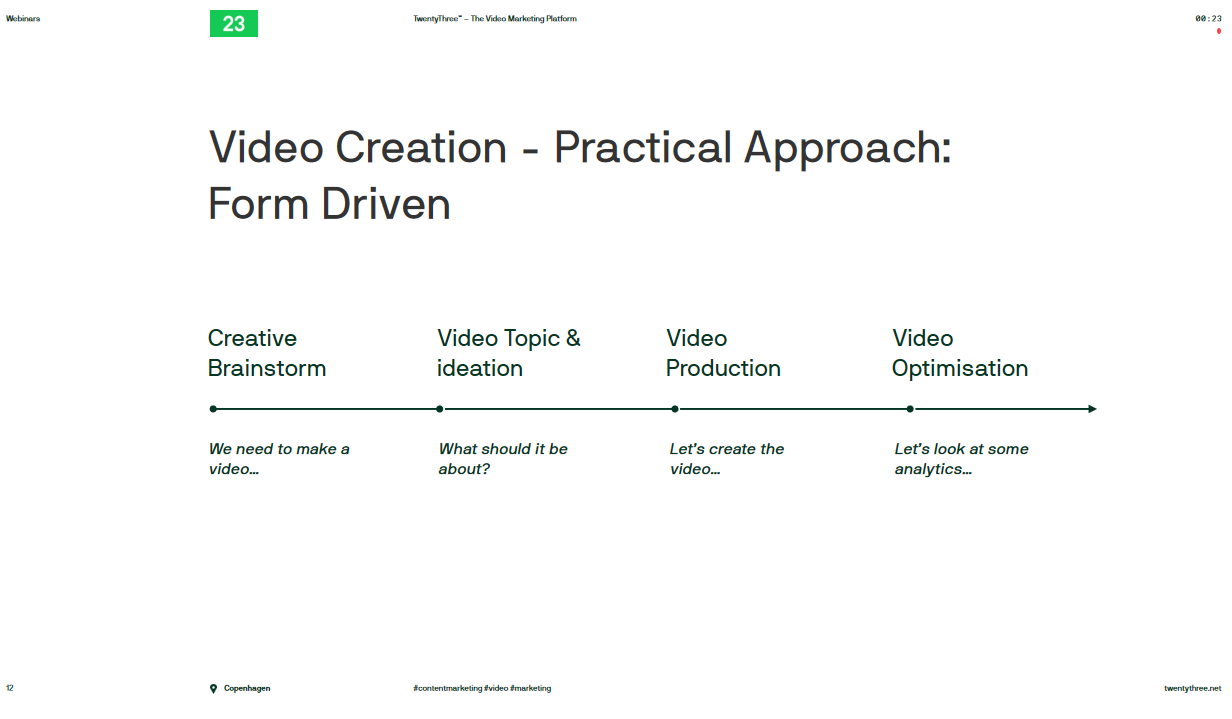
Video Creation - Practical Approach: Form Driven" is a systematic method of creating a video that is driven by the form of the video. The steps involved in this approach include:
- Creative Brainstorm: This is the first step in the video creation process where you brainstorm ideas for your video. This step is important as it lays the foundation for your video concept and helps you to determine the purpose and message of your video.
- Video Topic & Ideation: In this step, you refine the video concept by selecting a topic and generating ideas for the video content. You should consider factors like the target audience, the purpose of the video, and the desired outcome when selecting a topic and generating ideas.
- Video Production: After the concept has been developed and refined, it is time to produce the video. This includes writing a script, setting up a shoot, capturing footage, and post-production editing.
- Video Optimisation: This is the final step in the video creation process and involves optimising the video for different platforms, devices, and audiences. It also includes adding calls to action, captions, and other elements to help increase engagement and drive results. By optimising your video, you increase the chances of reaching a wider audience and achieving your desired outcome.

Finding your Baseline
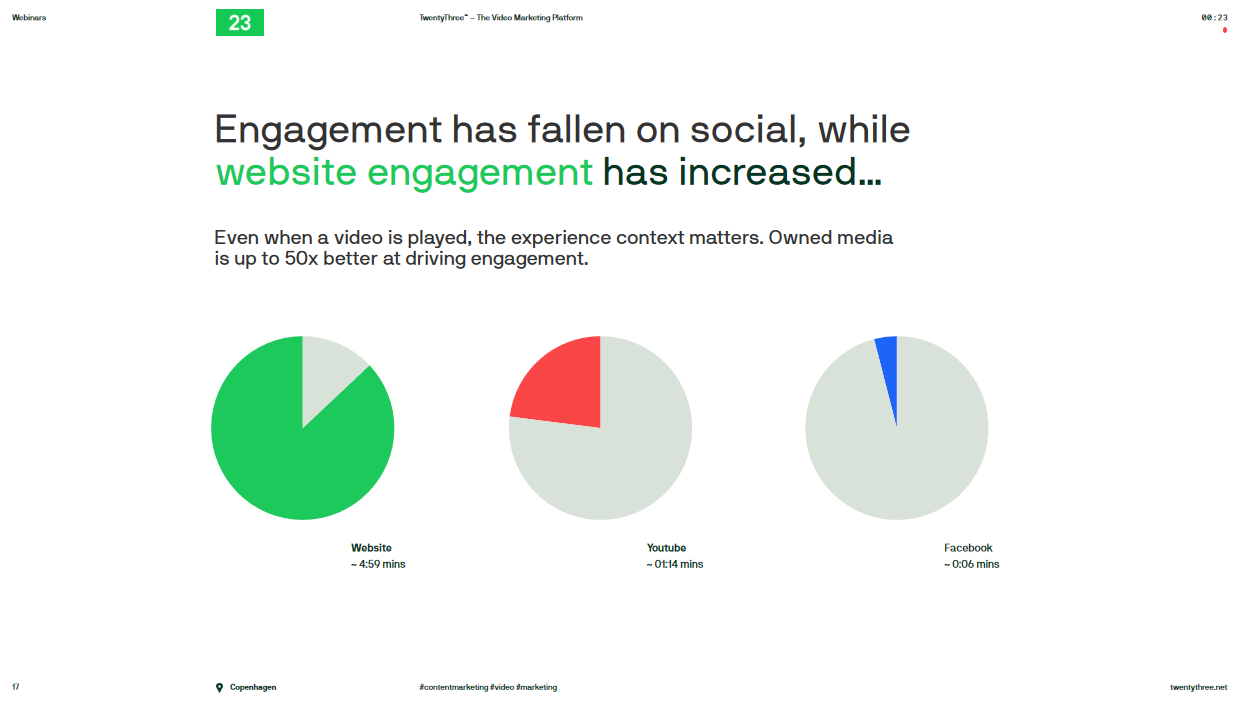
Automation/ Lead Scoring/ Integration to existing Mar-Tech
Automation/Lead Scoring refers to the use of software and algorithms to automate repetitive and time-consuming tasks in marketing and sales processes. This can include lead scoring, which is the process of assigning a numerical score to each lead based on their level of engagement, demographic information, and other data points.
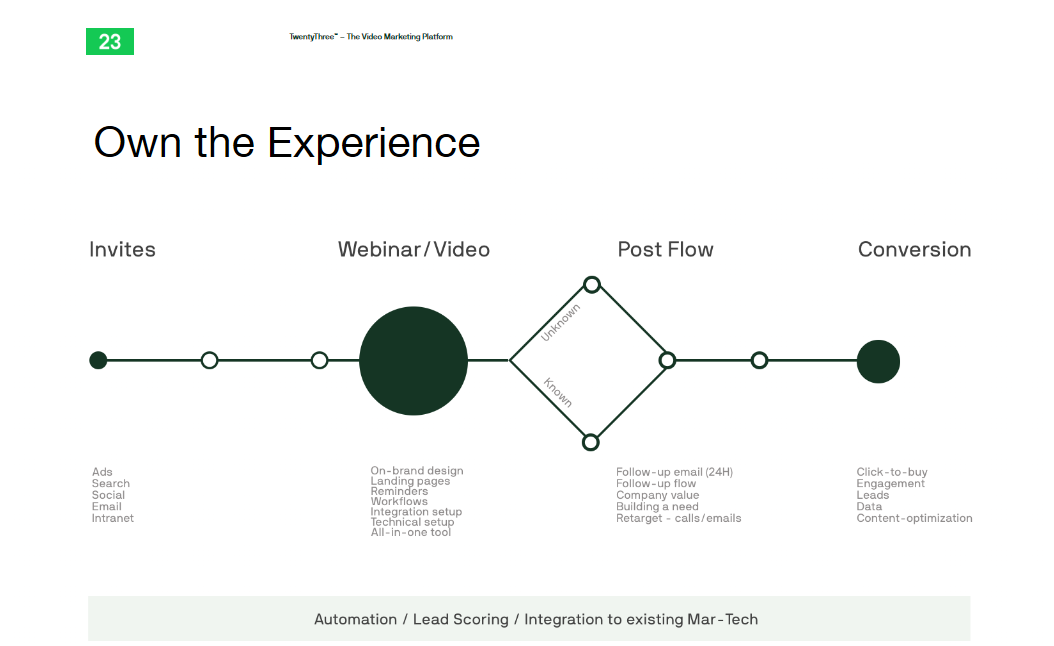
Integration to existing Mar-Tech refers to the process of connecting different marketing technology tools to work together seamlessly. This is important for businesses to streamline their processes, improve data management, and provide a better overall experience for both customers and employees.
By integrating automation/lead scoring into their existing marketing technology, businesses can increase efficiency and improve the effectiveness of their marketing efforts. The automation can help prioritize leads, trigger targeted communication, and provide valuable insights into customer behaviour. Lead scoring can help businesses determine which leads are most likely to convert, making it easier for sales teams to focus their efforts on the most promising prospects.
Video Creation - Practical Approach: Goal Driven
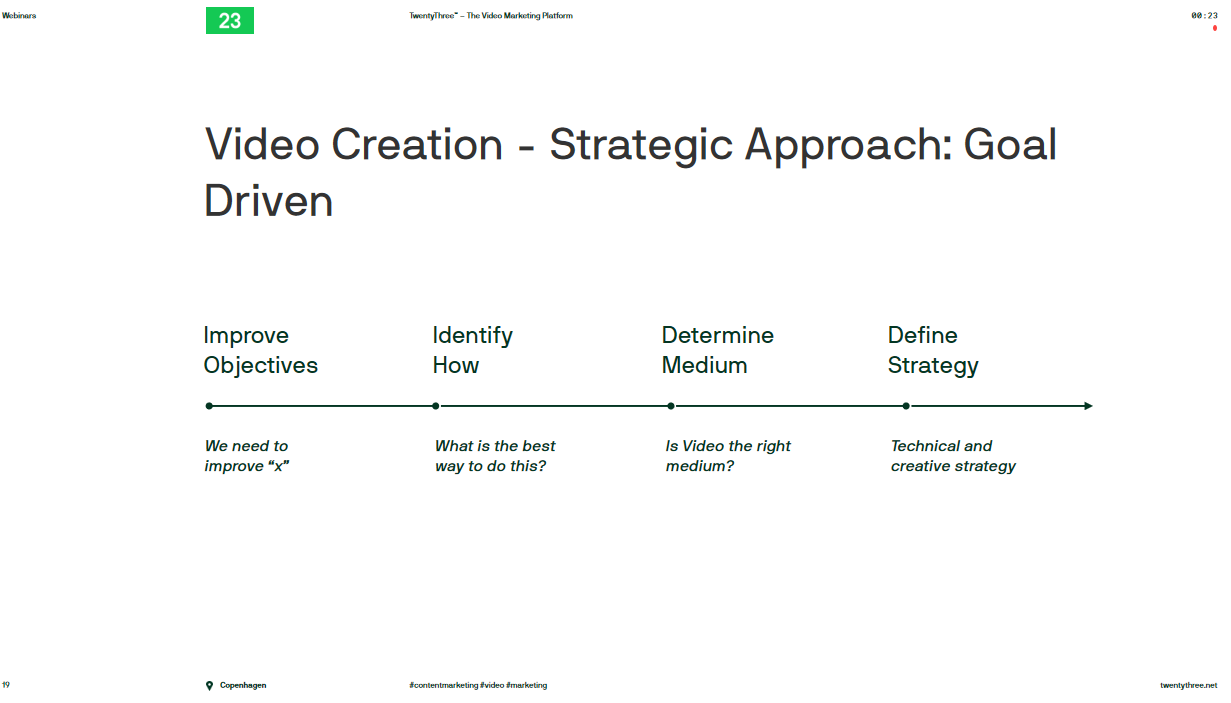
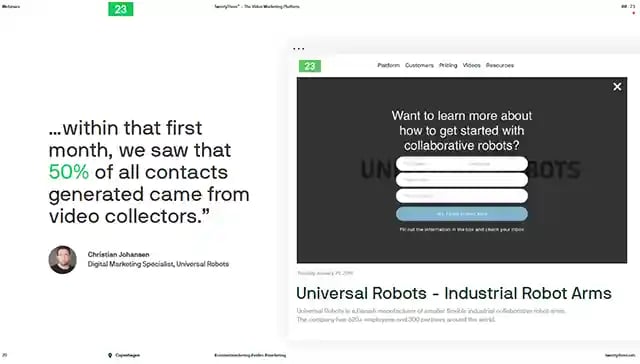
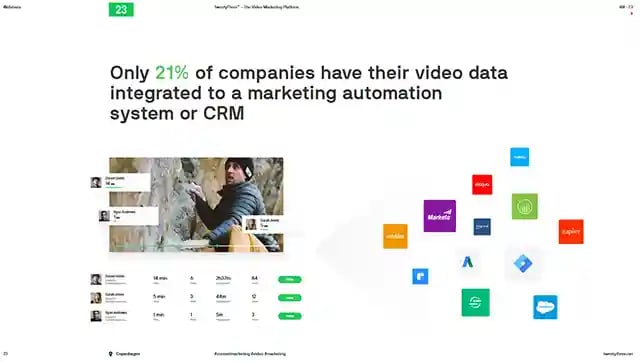
HubSpot Media Bridge
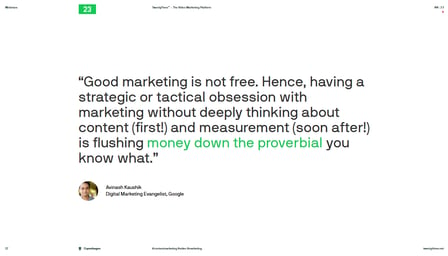
The HubSpot Media Bridge is a feature that connects your video marketing with your HubSpot marketing and sales platform. This allows you to integrate your video content into various aspects of your marketing and sales processes, creating a seamless and holistic experience for your customers.
key features of the HubSpot Media Bridge
- Connecting all your TwentyThree videos to HubSpot: With this feature, you can easily access all your video content from within the HubSpot platform, making it easier to manage and distribute your video content.
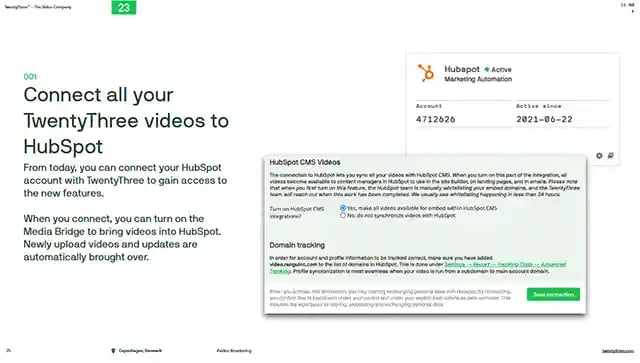
- Adding videos directly to websites and landing pages: The HubSpot Media Bridge allows you to add videos directly to your websites and landing pages, making it easier for your customers to engage with your video content and increasing the chances of conversion.
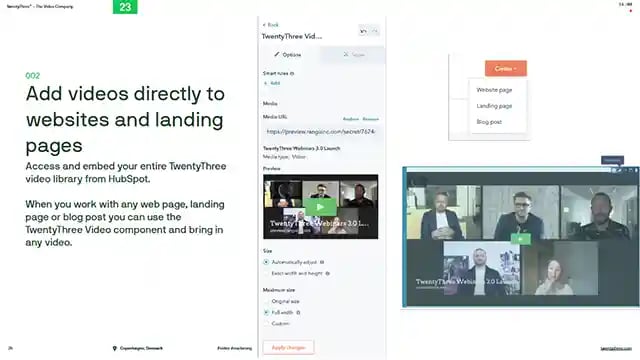
- Integration with email marketing: With the HubSpot Media Bridge, you can make sure that your videos are integrated with your email marketing, allowing you to reach more customers and increase the impact of your marketing efforts.
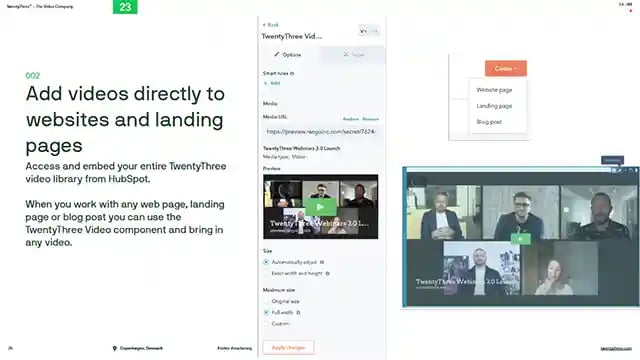
- Best video features from TwentyThree: The HubSpot Media Bridge offers access to the best video features from TwentyThree, giving you more tools to engage with your customers and drive more value from your video marketing.
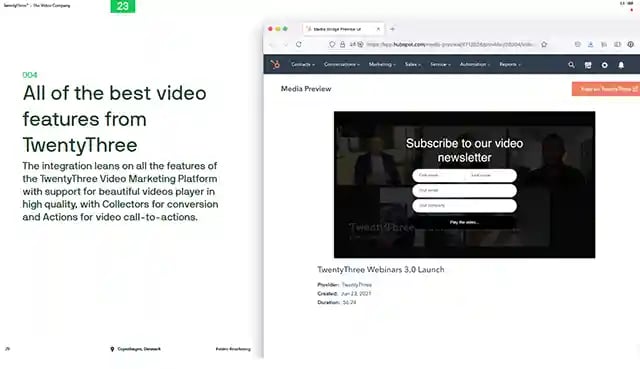
- Viewer’s contact timeline in the CRM: The HubSpot Media Bridge allows you to see plays on the viewer’s contact timeline in the CRM, giving you more insights into customer engagement and allowing you to personalize your interactions.
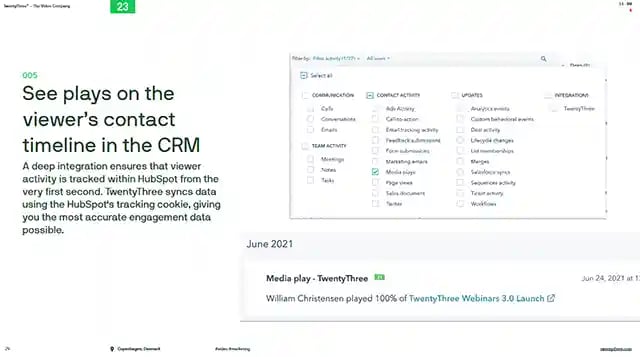
- Video engagement in revenue attribution: The HubSpot Media Bridge enables you to use video engagement in your revenue attribution, allowing you to measure the impact of your video marketing on your overall business results.
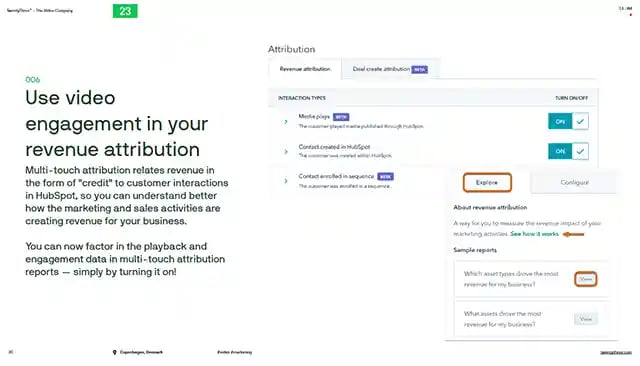
- Custom HubSpot reports: The HubSpot Media Bridge allows you to build custom reports using video engagement data from your contacts, giving you more visibility into the impact of your video marketing and allowing you to make data-driven decisions.
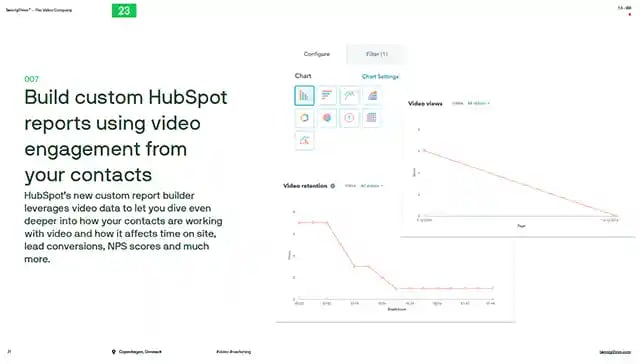
Overall, the HubSpot Media Bridge is a powerful tool that can help you take your video marketing to the next level by integrating it with your marketing and sales processes, creating a more seamless and impactful experience for your customers


